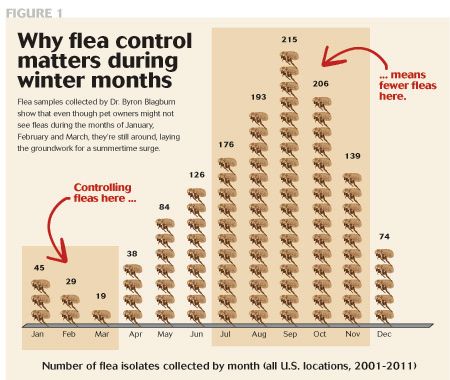Flattening the curve: A data-driven look at flea control
You know it's crucial for pet owners to curb these critters year-round. But here's a striking visual representation of why.
Just when you thought you'd heard it all when it comes to the importance of parasite control in companion animals (whether you're a veterinarian or a dvm360 editor), you sit through a talk by Byron Blagburn, PhD, the gentleman statesman of the veterinary parasitologist crowd, and get a whole new perspective.

Dr. Byron BlagburnBlagburn, in a lecture presented during a recent CVC, discussed how the time necessary to control fleas depends on the number of fleas in the environment, not the number of fleas on the pet. And anyone who remembers the flea pyramid knows that eggs, larvae and pupae far outnumber adult fleas when an infestation is present.
When eggs lie deep in the carpet and temperature and humidity conditions are ideal (regardless of time of year), they will hatch and commence their life cycle-which is highly likely to involve the family pet.
To drive home the point, Blagburn showed a slide reflecting the number of flea samples he had received at his parasitology lab at Auburn University as part of a flea susceptibility monitoring study sponsored by Bayer Animal Health.1 The samples, which were collected from veterinary hospitals all over the country, were charted on a month-by-month basis (see Figure 1). “I feel that numbers of specimens submitted by participating veterinary hospitals represent, in general, the trends in flea prevalence and populations on pets,” Blagburn says.

While fleas are less numerous during January, February and March, they're still present. “Down here,” Blagburn told his CVC audience, pointing at the low-prevalence months, “we're administering product when you don't see fleas so you don't have to do battle later on.
“If you start here,” he continued, referring to the peak months, “it's going to take a good while to bring your infestation down. If you start in winter, you'll flatten this curve out very nicely. That's the intention of a well-thought-out flea control strategy.”
Reference
1. Blagburn B, Kopp S, Rust M, et al. Cat flea susceptibility to imidacloprid: Results of a 14-year monitoring initiative (abstract). Proceedings of the American Association of Veterinary Parasitologists 60th Annual Meeting, July 11-14, 2015, Boston, MA.
Podcast CE: A Surgeon’s Perspective on Current Trends for the Management of Osteoarthritis, Part 1
May 17th 2024David L. Dycus, DVM, MS, CCRP, DACVS joins Adam Christman, DVM, MBA, to discuss a proactive approach to the diagnosis of osteoarthritis and the best tools for general practice.
Listen